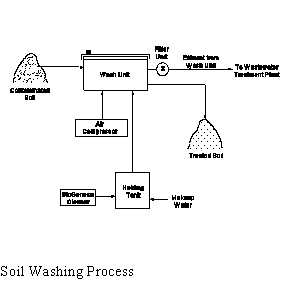
(BioGenesis Soil and Sediment Washing Process)
The BioGenesis soil and sediment washing process uses specialized, patent-pending equipment, complex surfactants, and water to clean soil, sediment, and sludge contaminated with organic and inorganic constituents. Two types of mobile equipment wash different sizes of particles. A truck-mounted batch unit processes 20 yards per hour, and washes soil particles 10 mesh and larger. A full-scale, mobile, continuous flow unit cleans sand, silt, clay, and sludge particles smaller than 10 mesh at a rate of 20 to 40 yards per hour. Auxiliary equipment includes tanks, dewatering and water treatment equipment, and a bioreactor. Extraction efficiencies per wash cycle range from 85 to 99 percent. High contaminant levels require multiple washes.
The principal components of the process consist of pretreatment equipment for particle sizing, a truck-mounted soil washer for larger particles, a sediment washing unit(s) for fine particles, and water treatment and reconditioning equipment. The BioGenesis soil washing system for larger particles consists of a trailer-mounted gondola plumbed for air mixing, water and chemical addition, oil skimming, and liquid drainage (see figure below). Water, BioGenesis cleaning chemicals, and soil are loaded into the gondola. Aeration nozzles feed compressed air to create a fluidized bed. The resulting slurry is agitated to release organic and inorganic contaminants from the soil particles. After mixing, a short settling period allows the soil particles to sink and the removed oil to rise to the water surface, where it is skimmed for reclamation or disposal. Following drainage of the wash water, the treated soil is evacuated by raising the gondola's dump mechanism. Processed soil contains a moisture level of 10 to 20 percent depending on the soil matrix.


A prototype BioGenesisSM sediment washing machine was tested in Environment Canada's Contaminated Sediment Treatment Technology Program. The sediment washing machine is a continuous flow unit. Capacities of up to 80 to 100 cubic yards per hour are possible using full-scale, parallel processing equipment.
In the sediment washing machine, sediment is pretreated to form a slurry. The slurry passes to a shaker screen separator that sizes particles into two streams. Material greater than 1 millimeter (mm) in diameter is diverted to the large particle soil washer. Material 1 mm and smaller continues to the sediment washer's feed hopper. From there, the slurry is injected to the sediment cleaning chamber to loosen the bonds between the pollutant and the particle.
After the cleaning chamber, the slurry flows to the scrubber to further weaken the bonds between contaminants and particles. After the scrubber, the slurry passes through a buffer tank, where large particles separate by gravity. The slurry then flows through hydrocyclone banks to separate solids down to 3 to 5 microns in size. The free liquid routes to a centrifuge for final solid-liquid separation. All solids go to the treated soil pile; all liquid is routed to wastewater treatment to remove organic and inorganic contaminants. Decontaminated wastewater is recycled back through the process. Equipment configuration varies depending on the soil matrix.
The BioGenesis cleaning chemical is a light alkaline mixture of ionic and nonionic surfactants and bioremediating agents that act similarly to a biosurfactant. The proprietary cleaner contains no hazardous ingredients.
This technology extracts many inorganics, volatile and nonvolatile hydrocarbons, chlorinated hydrocarbons, pesticides, polychlorinated biphenyls (PCB), polynuclear aromatic hydrocarbons, and most organics from nearly every soil and sediment type, including clay.
The BioGenesis soil washing technology was accepted into the SITE Demonstration Program in June 1990. The process was demonstrated in November 1992 on weathered crude oil at a refinery site in Minnesota. Results from the demonstration have been published in the Innovative Technology Evaluation Report (EPA/540/R-93/510) and the SITE Technology Capsule (EPA/540/SR-93/510). The reports are available from EPA. BioGenesis Enterprises, Inc., is planning a future demonstration of the BioGenesis sediment washing process using PCB-contaminated sediment.
Results of the SITE demonstration are presented below:
EPA PROJECT MANAGER:
Annette Gatchett
U.S. EPA
National Risk Management Research Laboratory
26 West Martin Luther King Drive
Cincinnati, OH 45268
513-569-7697
Fax: 513-569-7620
TECHNOLOGY DEVELOPER CONTACT:
Charles Wilde
BioGenesis Enterprises, Inc.
7420 Alban Station Boulevard, Suite B 208
Springfield, VA 22150
703-913-9700
Fax: 703-913-9704